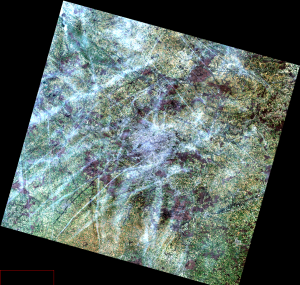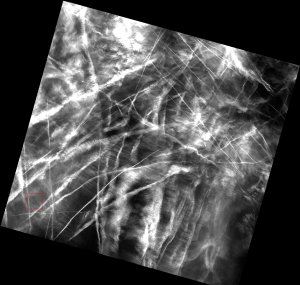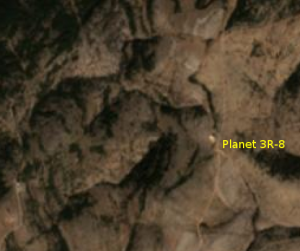Satellite detection by satellite
![]() =>
=> ![]() Airplanes largely disrupt our remote sensing images, because of the ice contrails they leave behind them, which often turn into cloud cover. We had to set up a method for detecting and correcting aircraft contrails.
Airplanes largely disrupt our remote sensing images, because of the ice contrails they leave behind them, which often turn into cloud cover. We had to set up a method for detecting and correcting aircraft contrails.
LANDSAT 8 image acquired over Paris on 14/04/2013. On the left, RGB color composition, on the right, image of the 1.38μm band. Given the number of traces of planes, we might have to choose between flying or observing the earth.
And the future is quite worrying (generally speaking, the future is more worrying than the past): according to my colleague from CNES, Christophe Bonnal: « The US company One Web has the ambition to deploy 600 satellites within three years three to offer broadband internet access from space. Several companies have similar projects in drawers : Boeing has announced the sending of 2400 satellites, Samsung sits at 4000, while Elon Musk speaks bluntly of 12,000 spacecrafts « .
Given the large number of satellites, I wondered if it was possible that the images of Sentinel-2 were disturbed by the presence of satellites located a little lower. The possibility is quite high, because finally, most optical observation satellites seek to make their observations around 10:30 in the morning. With a good orbit propagator, and thanks to Norad’s data, it’s pretty easy to find the moments when one of the Sentinel-2 passes over one of the Planet satellites just below. And with that information, accurate to a few tenths of meters, we can search for the satellite in the image
Well, the phenomenon is still modest, thanks to the small size and low orbit of Planet satellites, but if large constellations are launched at an altitude closer to that of Sentinel-2, they can cover many pixels.Will we have to resort to the technique recently developed by the indian government to
avoid multiplying white spots on our images ? And of course, this text was published on the first of April, and the « satellites » shown in the images are just white spots, probably not satellites, but who knows 🙂















